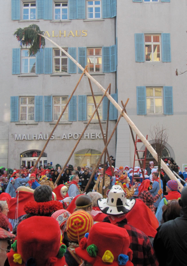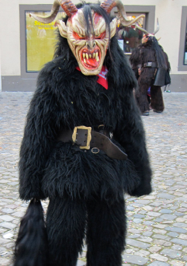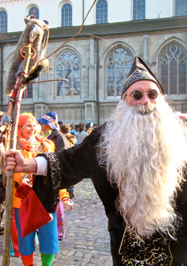fasching in konstanz
south side of Lake Constance
Baden-Württemberg, GERMANY
europe


fasching in konstanz
south side of Lake Constance
Baden-Württemberg, GERMANY
europe


Carnival is celebrated in many parts of the world, and Carnival, or Fasching, a variation of the term Faschnacht, refers to the celebrations that fall on the Tuesday Eve before Ash Wednesday, or the eve before the fast. Carnival in Brazil, Carnival in Venice, Mardi Gras in New Orleans, and Fasching in Konstanz all have the reputation as being big celebrations, each in their own unique fashion. These celebrations are connected to some of the oldest rituals known to humankind, containing a number of fertility rites and customs like the ritual of driving out winter. The existence and origin of these rituals are well-documented in early myth and primitive drawings. In the center of religious rites and rituals stand the mask, the dance, and the procession. The human desire to disguise, to assume a different role, is as old as mankind itself. Henry and I were encouraged to return to Konstance to participate in the Fasching celebrations by friends we had met earlier in this fascinating city on the Bodensee. Timing was perfect, as my release from the Klinik in Munich was on the morning of the 7th, just in time to take a train to Konstanz, meet our friends, and see the fantastic parade. The local guilds, each group in a different costume with matching masks, whips, bells, etc. made an impression on the crowds lining the narrow, cobblestone streets of this lovely Medieval to Baroque period town. The following morning, we met, each of us dressed in costume, ready to further disguise ourselves with a bit of theatrical grease-paint. Our friends, Agnes Joester and Eberhard Belz, one a psychologist and the other a psychiatrist, were our hosts and guides to this event, and Agnes expertly helped us with the face painting. This lovely couple had made arrangements for every moment of our day and evening, which was fascinating fun and quite the marathon. We began the day shortly after breakfast, then proceeded to a kick-off party at the Rathaus or Town Hall, where the officials hosted a party in the courtyard of this fine building. Non-alcoholic gluhwein, coffee and tea an a snacks were served by a family dressed as pirates. From there we moved onto the street, where the local residents began to gather. We walked all over town to find the secret cellars and places that were set up for this “party-til-you drop” event. Bands with bass drums, tubas, and trumpets arrived to add music to the crazy atmosphere. Families, all dressed alike, some with costumed babies in strollers, joined in the fun. Late morning, the costumed citizens of Konstanz paraded along the streets, as more participants, and even full bands, arrived by train from the surrounding towns and villages. The cobblestone streets and alleyways were draped with streamers overhead, colorful strips of fabric strung across the passageways. Everyone was having fun and “HO NARO” was the day’s greeting to one another. This shouted greeting, a meaning-less word, created camaraderie and evoked the crazy, fun-filled atmosphere that permeated the day. Around noon, a huge crowd gathered to watch the “judicial” process where the mayor was put on trial. He arrived in costume, with his defense attorney dressed as an 18th century Jacobin. The crime for which the mayor was being judged was none other than driving his yellow Ferrari around town, a little too fast maybe. His defense: driving an Italian-made vehicle was good for the economy of the European Union ! Speeches were made by all parties and the verdict was read. The mayor was soon dressed in black-and white jail striped pajamas and was ordered to serve soup to the crowd. While this was going on, we quietly slipped away into the Barbarossa Hotel, the city’s famous 15th century inn that had served as the backdrop to the the mayor’s roasting. The four of us joined the elite guests in the hotel’s restaurant filled with trestle tables, and ordered typical German cuisine to enjoy lunch with the costumed crowd. The antics, the costumes and the joviality were great fun. Beer and wine flowed, and everyone, including the mayor, had a great time. Afterwards, Henry and I watched the annual raising of the Fasching Tree from the the porch of the hotel. This old tradition, accompanied by the music of a high-school band sporting red yarn wigs, was amazing to watch. A conifer tree, with branches at its top, was hoisted bit by bit using and old method of supports and ingenuity to reach its full 18 meter/60 foot upright height. The early hours of the afternoon brought more parading about, with a chance to see the costumes and enjoy the outgoing friendship of the people, while Henry and I photographed the event. The four of us parted company for a few hours to rest, shower, change clothes and regroup for the evening’s events. We put on the “uniform” of nightshirts worn over warm clothes. Both of us donned stocking caps, and I wore mine over a silly blonde wig with pigtails. We then met our friends and headed for a parade that started after dark. Groups of school children, their parents and some teachers, all dressed in white nightshirts, carried torches and big placards to denounce the teaching skills and eccentric personalities of the classrooms’ teachers. There was music and drumming within the parade along the narrow winding streets, as a huge puppet in white pajamas was activated from a window above our heads, where the residents in the surrounding historic houses cheered the massive numbers parading on the street below. Great fun was had by all as we joined the parade to run along or stop, squatting low with the rest of the group. Once beyond the crush of the crowd, we headed toward one of the fortress towers, one of the two or three left from the walled city of 20 original towers. Inside this clubby atmosphere, we had a snack of meat, cheese, and wine, then were given a private tour of the Fasching Museum on the floors above us. A pub crawl ensued afterwards, where the four of us ambled from place to place to get a sense of the atmosphere and to visit with friends new and old. Finally, Henry and I collapsed with exhaustion ... around 1 AM -- and made it back to our hotel to crash. The following morning, we met Agnes, Eberhard and their daughter, Caroline to have breakfast, then walk around town. The remnants of the Fasching revelry had been totally cleaned up by early morning! This lovely family was so hospitable that they kept us company until it was near time for our train to depart for Munich. Parting was such sweet sorrow!
PHOTOS: Left Column: 1. A wizard near Konstanzer Münster Cathedral. 2. Agnes Joester & Eberhard Belz in costume. Both costumes disguise these friends of ours. Agnes is actually a blonde! 3. A devil in full, effective gear. Center, Top: Mouse and cat make friends at Barbarossa. Center, Middle: The bells on this costume will definitely chase winter away. Center Bottom: A 17th century Dandy looking great on the streets of Konstanz. Right Column: 1.The raising of the Fasching tree in a square near the 15th century hotel Barbarossa. 2. Henry and Jourdan in costume. Henry’s costume disguised him as a dirty old man -- a simple rubber nose did the trick. Jourdan’s costume was handmade by Agnes for her daughter, Caroline, now aged 16, when she was only 10 or 11! 3. Crusaders from past and future hang out beside the Konstänzer Münster Cathedral. 4. The Changing of the Guards were a moveable feast ... the guard houses were on wheels!

Carnival









